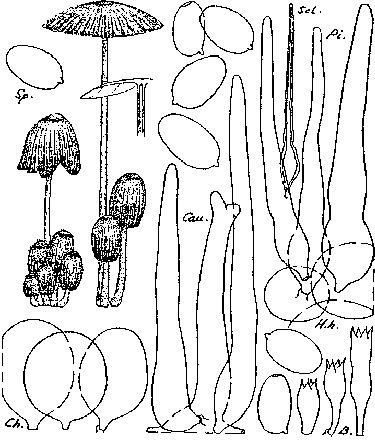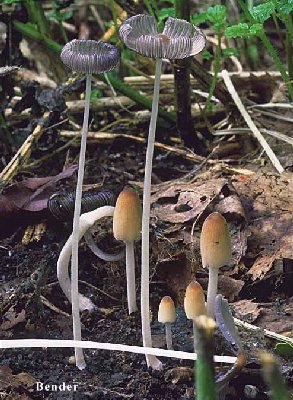Macroscopic features |
Closed pileus up to 18 x 12 mm, dirty red-brown, cinnamon, ochre to rather pale (yellow-)brown (Mu. 7.5 YR 3/2, 4/6, 10 YR 5/3, 5/6, 6-8/6 to 2.5 Y 5/4, K. & W. 6D6, 5D5, 4A4) at centre, paler towards margin (Mu. 7.5 YR 6/5, 10 YR 5/5, 6/2-3, 7/3, 5/2, 2.5 Y 7-8/4, 6/2, K. & W. 6C4-5, 5D6-7 to 3-4, 5B3, 4B4, 4A3); up to 35 mm wide when expanded. Lamellae free, white to blackish; L= 18-36, l= 0-3. Stipe 50-120 x 1-3, white to greyish-white, with base up to c. 4 mm wide, pubescent. |
Microscopic features |
Spores [220,11,11] 9.3-13.1 x 5.7-7.4 µm, av. L= 10.3-12.1, av. B= 6.1-6.9 µm, Q= 1.50-1.95, av. Q= 1.65-1.90, ellipsoid to ovoid; germ pore weakly to rather strongly eccentric, c. 1.8 µm wide. Basidia 14-38 x 8-10 µm, 4-spored. Pseudoparaphyses 4-6 per basidium. Cheilocystidia globose and 20-50 µm in diam., to ellipsoid and 20-60 x 15-40 µm. Pleurocystidia absent. Pileocystidia 60-150 (-200) x 6-25 µm, lageniform with 4-8 (-10) µm wide, tapering neck. Sclerocystidia usually present. Clamp-connections present. |
Habitat |
Terrestrial, usually at or near wood fragments, particularly on paths covered with wood chips. (Sub)fasciculate. Common. |
Remarks |
In the Netherlands C. callinus is a common species, especially on paths covered with wood-chips. In this habitat the species is often abundant and grows in distinct fascicles. |

[Copyright © by Uljé]

[Copyright © by Hans Bender jbe8995374@aol.com]